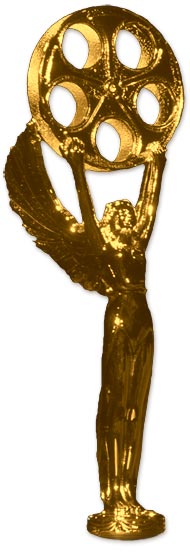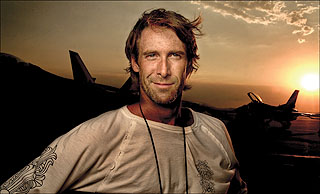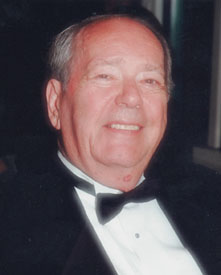2008 Golden Reel Awards

Click on the links to the left (under "Past Awards") for the complete list of nominees and Golden Reel Award recipients.
2008 MPSE Filmmaker Award Recipient
Michael Bay

After launching his career as an award-winning commercial and music video director, Michael Bay quickly emerged as one of Hollywood's boldest and most bankable feature film directors. Characterized by his aggressive visual style and high-octane action sequences that have become the L.A. native's cinematic signature, the films that Bay has directed and produced have hit $3 billion in worldwide ticket sales.
Now established as one of the industry's elite action filmmakers, Bay has been dazzling audiences since the premiere of his first feature film, Bad Boys, starring Will Smith and Martin Lawrence, in 1995. The $9 million film won Best Action Sequence at the MTV Movie Awards, and it grossed over $140 million worldwide, making it Columbia Pictures' top-grossing film of that year. Bay's impressive sophomore effort, The Rock, starring Sean Connery and Nicolas Cage, followed a year later. Shot on location on Alcatraz Island in San Francisco Bay, The Rock surpassed Bay's blockbuster debut, taking in more than $335 million worldwide. His third directing effort was Armageddon, an idea he came up with, with writer Jonathan Hensleigh; Bay produced with Jerry Bruckheimer. Armageddon starred Bruce Willis, Ben Affleck and Liv Tyler, and earned over $550 million around the globe.
Bay continued his hot streak in 2001, directing the epic Pearl Harbor and sharing producer credit on the film with Bruckheimer. Their collaboration once again bore fruit, as Pearl Harbor raked in $450 million in box office receipts worldwide, and at the time became the best selling DVD of all time. In 2003, Bay reteamed with Smith, Lawrence and Bruckheimer for the summer hit Bad Boys II. The filmmaker's followed that effort with the action thriller The Island, starring Ewan McGregor, Scarlett Johansson, Djimon Hounsou, Sean Bean and Steve Buscemi.
Bay's most recent film was the story of the summer of 2007: Transformers. Bay turned an 80s cartoon into an exciting live-action blockbuster that grossed over $700 million worldwide, making it Bay's most successful film to date, and established it as Dreamworks' biggest film franchise. Following its theatrical run, Transformers was the bestselling DVD of 2007.
Bay is currently at work developing a sequel to Transformers, slated for a summer 2009 release.
Bay's production company, Bay Films, remains one of the most cutting-edge production entities in Hollywood today and continues to grow. Five years ago, Bay joined forces with producers Brad Fuller and Andrew Form to create Platinum Dunes, a company whose mission is to make films with budgets under $20 million that would give talented commercial and video directors the chance to break into the feature world. The first offering from the company was The Texas Chainsaw Massacre, a re-imagining of the 1974 cult classic, which opened to top-notch reviews and grossed over $110 million worldwide. The company's second film, The Amityville Horror, reached receipts of more than $108 million. Two more films quickly followed: the original script, Texas Chainsaw Massacre 2: The Beginning, which earned $51 million; and a re-conceptualization of the 1986 thriller, The Hitcher, that garnered $20 million. Platinum Dunes's next film is The Horsemen, starring Dennis Quaid, Ziyi Zhang, Peter Stormare and Eric Balfour under the direction of Jonas Akerlund, and executive-produced by Bay. Also on the slate are re-imaginings of Friday the 13th, Near Dark, and The Birds, as well as the original Fiasco Heights.
Last year Bay and two partners bought one of the film industry's premier digital effects houses, Digital Domain, from James Cameron. A world leader which provided effects in Titanic, Transfomers, and Pirates of the Caribbean, the company is expanding into video games and will be the first production house to build an animation film in a gaming engine, which will greatly reduce animation costs.
One week out of out of film school in 1989, Bay began directing commercials and music videos for Propaganda Films. His works for such acts as Meat Loaf, Aerosmith, Tina Turner, Donny Osmond, and the DiVinyls won the young filmmaker recognition, acclaim, and a number of MTV Video Award nominations. He won the coveted Best Music Video prize in 1992 and 1999.
When Bay's first television spot -- for the American Red Cross -- was honored with a Clio in 1992, it heralded the aspiring film director's rapid ascent from unknown film school grad to creative force. Over the next three years, the Wesleyan University graduate would direct some of the best known and most acclaimed advertising campaigns in the world, including those for Nike, Budweiser, Coca Cola, Reebok, Miller and Victoria's Secret. In 1995, Bay, at the young age of 27, was honored by the Directors Guild of America as Commercial Director of the Year.
Bay is the youngest director to have won nearly every award bestowed by the advertising industry. He won the Grand Prix Clio for Commercial of the Year for the irreverent "Got Milk?/Aaron Burr" commercial; this famous spot was voted into the top ten classic spots of all time. Bay's famous "Got Milk" campaign now resides in the permanent collection of New York's Museum of Modern Art.
2008 MPSE Career Achievement Award Recipient
Bill Wistrom

As a young man in Santa Monica in the early 1950's, Bill was already in love... with movies and filmmaking. In late 1953 he got his chance -- starting in the mailroom at Paramount Studios. In 1954 a position in film shipping opened up and Bill transferred. It was during the slow times in shipping that he was able to observe picture editors at work. Soon he was apprenticing with Bob Swink on The Desperate Hours and Anna Bauchens on Cecil B. DeMille's The Ten Commandments.
In 1955 a paying gig as a sound editing apprentice opened up and Bill was accepted. One of his earliest jobs was continuing his post production experience on The Ten Commandments with the sound editing team of Tom Middleton and Howard Beals.
Few sound editors today could imagine working on an early Foley session like Bill did; standing with several other sound editors, grips and construction workers on Paramount's western street -- directed by Mr. DeMille himself. The filmmaker had the small army of people chopping hay, pounding mud and lifting heavy objects to create the soundtrack of the enslaved Israelites building the Egyptian pyramids and monuments. They worked at night to reduce the amount of traffic noise since this was being shot outside in the middle of Hollywood instead of in a recording studio. Being new, Bill at first thought that the famed director was just another guy yelling at people. But what he admired was that Mr. DeMille really cared about getting the sound right.
During this time, in February 1955, Bill became a card-carrying member of the Motion Picture Film Editors (now MPEG). As part of the studio’s sound staff he worked on a number of features, one after the other, gaining valuable experience.
In 1959 a new medium came calling: Television. Many feature sound editors were not interested in working for "that little screen," but Bill saw the opportunity and for the next 14 years supervised and edited on "Bonanza." In 1967 he took on the additional responsibility of Post Production Coordinator on "High Chaparral." These shows eventually ended and Bill "moved" to Walton Mountain, editing that landmark series with Vic Guarnier.
During a summer hiatus Bill had the great pleasure of supervising Sam Peckinpah’s classic Pat Garrett & Billy the Kid at MGM with Milton Burrow. Returning to "The Waltons," Bill stayed on at Lorimar working on several TV shows and Movies of the Week.
In 1975 Bill returned to MGM with Milt Burrow to supervise John Milius' epic The Wind and the Lion.
Later that year Bill was approached by Glen Glenn Sound’s Rick Larson, Emery Cohen, Rom Kobayashi, and Joe Kelly. They were setting up the first all-electronic sound editing system (the PAP system) and wanted Bill's wide experience to enhance the project. Bill and his team put the system to work in late 1975 on the TV shows "Kojack," "Columbo," and "Westside Medical;" features The Muppet Movie, Raise the Titanic, Borderline, and Movie Movie; and movies of the week “Raid on Entebbe” and "Friendly Fire" -- the first electronically edited show to win the sound Emmy.
While still working on various MOWs and the series "Falcon Crest," Bill returned to Paramount to do temp dubs on the feature films Star Trek II: The Wrath of Kahn and Star Trek III: The Search for Spock.
His next step was to help pioneer an all-digital sound editorial system at Glen Glenn. In 1984 he, Jim Wolvington, and Bill Thiederman supervised Chris Cain's Where the River Runs Black, the first all digital sound job. To this day, Dolby Labs still uses it to demonstrate its first stereo optical track taken from a digital source.
Once again, Paramount re-entered Bill's life. In 1987 "Star Trek: The Next Generation" producer Peter Lauritson asked Bill and Jim Wolvington to create the sonic world for the new version of Gene Rodenberry's visionary masterpiece. This became a long-term gig, as Bill continued his Trek tour through "Deep Space Nine," "Voyager," and "Enterprise." At the end of the fourth and final season of "Enterprise," Bill decided the time was right to retire -- after 50 years in the sound trade.
Bill stays extremely active in the Academy of Television Arts & Sciences, the Motion Picture Sound Editors, and the Academy of Motion Picture Arts & Sciences. As much as he is enjoying retirement, his heart will always be with all the great friends and collaborators he had the privilege to work and create with. They share this honor with him.

